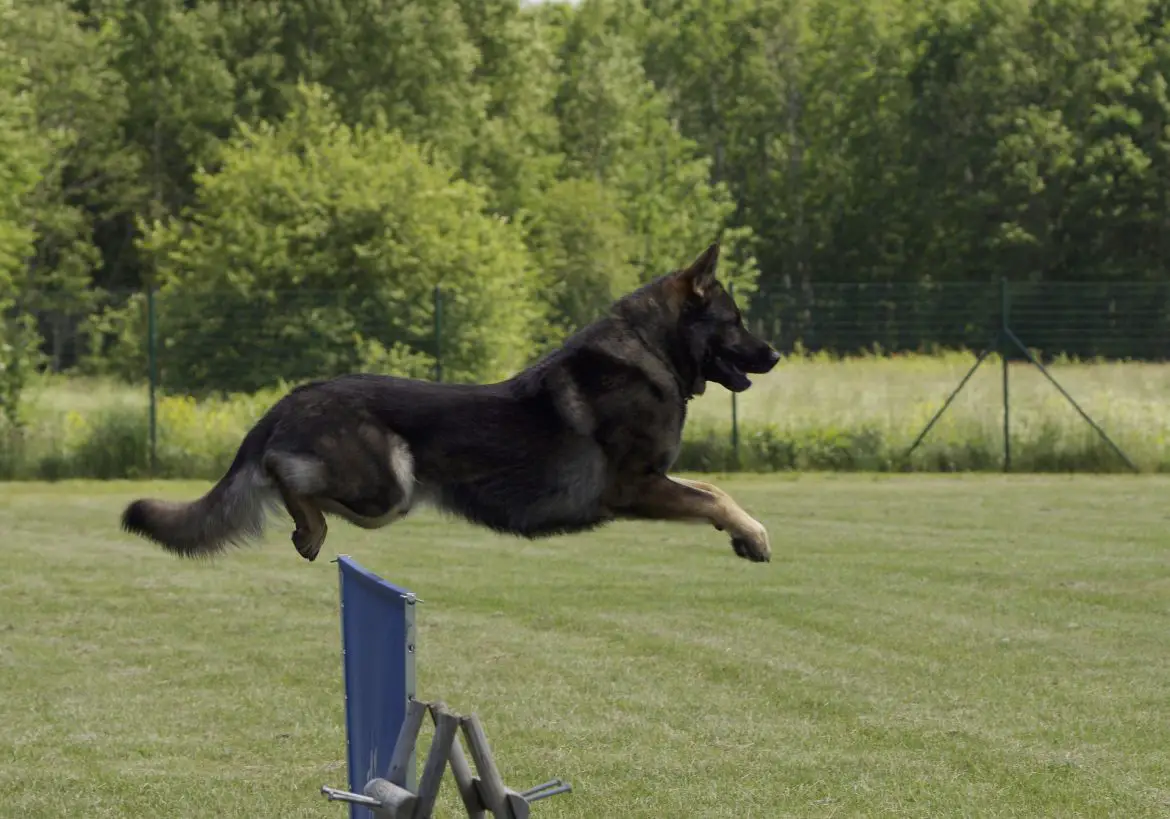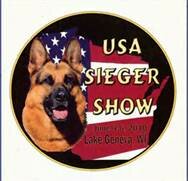Table of Contents
Since the Germans registered the first Deutscher Schaferhund or German shepherd in 1899, the most impressive feature of the breed has been its working abilities. Therefore, the structure of the Sieger show ( “Sieger” means champion in German ) competition is based on showcasing the breed’s athletic abilities and stature. There are two main Sieger shows that take place worldwide. They are the German Sieger Show aka World Sieger Show, which is considered by some as the most impressive, and the USA Sieger Show.
German Sieger Show
The German Sieger Show (Bundessieger-Zuchtschau) aka World Sieger Show, dating back to 1899, is a veritable showcase of some of the best young German Shepherd dogs in the world. For a breeder or handler, attendance at this show is one of the highlights of the year, as it offers them the opportunity to witness firsthand the direction the German Shepherd breed as a whole is heading. It also serves as the culmination of a year’s worth of competition. For aficionados of the breed, it offers the opportunity to see some of the best the world has to offer and allows great first-hand contact with breeders of this wonderful dog.
The German Sieger Show is held over a period of three days, at which time over 1500 dogs will be shown. This is the largest German Shepherd dog show offered in Germany. The annual event is offered in a different city each year, drawing 30,000 spectators.
Requirements for Entrants
The dogs exhibited at the German Sieger Show have already been judged on numerous occasions and hold a Schutzhund title. They must be of excellent conformation, have correct dentition, and must have hip certification. They must have already received a ‘VG’ rating at a recognized show during the previous year, ensuring that the dogs entered at this international event have already been recognized for excellence within the breed.
Conformation and Gaiting
The German Sieger Show competition is divided up over the course of three days, with different judges handling the various portions of the test. Divided up by sex and by age, dogs will be judged on several different factors. They are judged on conformation, where their physical structure is analyzed. They will also be judged on their gait and movement. German shepherds are expected to exhibit ground covering stride coupled with excellent reach in the front and exceptional power from the rear.
Courage and Performance
During the German Sieger Show competition, the dogs will also be judged on their courage and obedience, participating in a test in which a gun is fired in their presence to make sure that they do not unduly react to the gunfire. The dogs will also be tested for their courage by participation in a performance test, which reflects the Schutzhund title held by the dogs. The dog and handler will approach a blind, at which time the helper, who is wearing special padded clothing, will emerge from behind the obstacle and threaten the handler. The dog is expected to protect the handler by biting the helper and holding on until he is released by the handler. The dog is then expected to attack another threatening helper at the other end of the field. The dog’s attitude, protective stance, and bite are all judged, as well as his willingness to release the bite upon command by his handler.
After proceeding through the various preliminary stages of the German Sieger show competition, the highest-ranking dogs will have their pedigrees examined, as the history and breeding of the dog plays a major role in the judge’s decision as to the ultimate award to be given to the top dogs in each class.
Awards and Titles
The judge will decide how to make his awards, giving the coveted award of Sieger to the top male dog, with the top female receiving the title of Siegerin. These awards indicate that these two dogs are the top German Shepherds in the world.
The judge will also award ratings of ‘VA’, which stands for excellent select, to a handful of dogs that were in contention for the Sieger Award. This rating is generally accorded to less than a dozen dogs at the competition. Dogs with a VA rank are considered the top specimens in the world. Since this rating is awarded to so few dogs, a typical dog with a VA rating may bring upwards of $100,000 if sold on the open market. Dogs with the highest awards also garner very high stud fees. Dogs will be rated with an indication of where they fell in the ranks; for example, the dog considered the best in the ‘VA’ rating will receive a rank of VA 1.
The remaining ratings which will be given to the dogs include ‘V’ (excellent), ‘SG’ (very good), ‘G’ (good), ‘A’ (sufficient), ‘M’ (faulty), ‘U’ I (sufficient), and ‘O’ (failed bite work).
How Puppies are Exhibited
Puppies are divided into age groups, in groups of 6-9, 9-12, and 12-18 months. They will be given a rating as indicated above, although the puppy classes do not include gun sensitivity testing nor the performance test. Puppies are judged on conformation, gaiting and temperament.
Summation
German shepherd dogs were historically the herding dog of the average working-class farming family. The German Sieger Show reflects that history, emphasizing overall performance, health, courage, and conformation in determining the awards to be given to the superior dogs shown at the event. These traits can be witnessed in person at the national German Sieger Show aka World Sieger Show.
USA Sieger Show
The USA Sieger show event lasts three days and is a contest between registered German shepherds. It is open to only German shepherds who are recorded in the USA Breed Registry or other FCI-recognized breed registries. When entering a dog in the USA Sieger Show, entrants must submit proper pedigree and registration papers for the dog during the check-in process. Training titles that are accepted are the HGH, DPO, IP, SchH, and any others considered acceptable by the Breed Advisory Committee to be admitted to compete in the USA Sieger show.
The following is a breakdown showing how the dogs are classified:
Baby puppy class: Dogs from 4 to 6 months old are judged in the baby puppy class.
Junior puppy class: Dogs from 6 to 9 months old are judged in the junior puppy class.
Senior puppy class: Dogs from 9 to 12 months old are judged in the senior puppy class.
Each dog judged in the USA Sieger show puppy class is given one of the following ratings:
- Less promising (LP).
- Promising (P).
- Very promising (VP).
Adult Dog Class
Dogs over 24 months old without a working title will be judged under the adult dog classification. Each dog is given one of the following ratings:
- Insufficient (M).
- Sufficient (A).
- Good (G).
- Very good (SG).
The above dog classifications will all be judged during the first day of the Sieger show competition. Some contests have eliminated the adult dog class altogether.
The next classifications will be judged on the Sieger show event’s second day, they are as follows:
Youth Classes
Dogs from 12 to 18 months old fall in the youth class.
Young Dog Classes
Dogs from 18 to 24 months old fall in the young dog class.
Dogs in the youth and young dog classes are each given one of the following ratings:
- Insufficient (M).
- Sufficient (A).
- Good (G).
- Very good (SG).
Next in the Sieger show competition, come the working dogs that are judged on their performance during the second day of the event following the youth and young dog classes. The classifications for this class are as follows:
Working Dog Classes
Dogs over 24 months old with a working title are judged in this category. Each dog is given one of the following ratings:
- Insufficient (M).
- Sufficient (A).
- Good (G).
- Very good (SG).
- Excellent (V).
- Excellent-select (VA).
Performance and Evaluation Tests
All canines within the working class must participate in the Sieger Show Performance Test. There are two aspects to this test. The first is judging the attack on the handler and the second is the pursuit and courage test. Each dog has three tries to successfully perform each exercise. Each attack must reach a predetermined distance from the blind to pass. This distance is noted as 20 feet. The attack will take place when the dog is between 10 and 15 feet from the blind. The distance from the blind to the starting point is over 60 feet.
Judges will evaluate the grip work of each dog as laid out in the USA’s Schutzhund Rule Book. The rule book states that each dog should counter the attack securely and energetically. When a dog has lacking self-confidence in grip work, they are considered sufficient in courage.
The out should show the dog is clearly off the sleeve and is moving into the guarding phase. The only permitted command is one word representing out. It can be any word that means out to that dog such as “aus”. The commands to sit or down are not permitted during this part of the competition.
After the attack, the handler should leash their dog without physical restraint. For example, no physically grabbing the dog to prevent re-grip. If a dog must be physically removed from the sleeve, they will be disqualified. Once the dog is on the lead, the exercise is completed.
During the pursuit or long grip, the dog can be held by the collar but not physically or verbally encouraged. The handler releases the dog when signaled by the judge. Each grip work and out will be evaluated similarly to the attack on the handler.
Dogs that do not demonstrate a correct performance test are ineligible for the excellent-select (VA) rating. The (VA) rating is the highest attainable award at the Sieger show and one the competitors strive for. Dogs that continue to bump or regrip post out will be placed at the end of their conformation rating. Dogs that do not perform the free heeling exercise within three attempts, do not perform the out, or received evaluations of sufficient or insufficient will be permitted from continuing in the competition.
After the performance test, all dogs receive the evaluation pronounced and are then given a standing examination. During the standing examination the following attributes are noted:
Judges look for the correct and proper structure, anatomy, and character of each dog. A gun sensitivity steadiness test is given to all age groups excluding the puppy classes. After this is completed, the dogs take part in a gaiting test. This showcases the muscles and bones and allows judges to determine if they work correctly and move in a certain rhythm. Strength, endurance, and liveliness are all evaluated during this aspect of the test.
Examples of Trophies, Titles and Prizes Awarded During the USA Sieger Show
Cash prizes awarded by the USA Sieger Show range in value from $50 to $250. Titles and trophies include the highest placing American breed, high-performance male, and first place trophies for male and female dogs representing every age group. However, more than any prize or trophy, the honor of winning a title in a Sieger show is the most sought-after award for any German shepherd owner or breeder.
The Sieger shows exist to ensure the German shepherd breed is well-respected and highly valued. Each type of show has its own unique set of rules, regulations, qualifications, and titles. Therefore, it is important to check the standards on a regular basis to stay abreast of any changing requirements. However, the long history of the great German shepherd breed has not altered much throughout the years.

